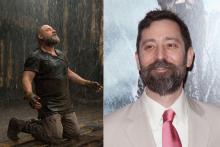Darren Aronofsky

Darren Aronofsky’s latest film The Whale has made a splash, both for Brendan Fraser’s heart-wrenching portrayal of the 600-pound Charlie and for critics’ accusations of fatphobia in the film.

Director Darren Aronofsky says he is not religious, and that his Russell Crowe blockbuster movie “Noah” is the “least-biblical biblical film ever made.”
But the strong environmental message of his film — which makes Noah a hero as a God-inspired steward of the earth — firmly roots itself in Scripture, Aronofsky told an audience of religious environmentalists on Wednesday. Many of them hope the message of the movie, which has grossed more than $300 million since its release on March 28, spurs more people of faith to work against climate change.
In “Noah,” Aronofsky said, he hoped to capture the beauty of creation, and to dramatize God’s dramatic decision to destroy it because of human sin. Noah, he said, “is saving the animals. He is not looking for innocent [human] babies. It’s about saving the animals.”

Biblical themes have been used throughout history to share the universal struggle of humanity; temptation, rebellion, coming of age, the degradation of the moral compass, courage in the face of humanity, and of course, faith.
William Shakespeare uses biblical elements in his plays. We witness in his writings themes highlighted in David's narrative, Adam and Eve's story, and Cain and Abel's tragedy. These stories are central to the Western canon. We cannot get away from these themes and stories, for they rest in the consciousness of our culture.
The film Noah, directed by Darren Aronofsky, is a daring, powerful, and imaginative retelling of the Noah story. Aronofsky takes the central elements of the biblical narrative and expands the story, as artists are called to do, to allow the audience to witness, not a historical world, but a metaphorical universe where the choices of humanity disrupt the sacred divine rhythm of creation.

I’ll begin by cutting to the chase: Forget most of what you’ve read about Darren Aronofsky’s new film, Noah. It opens Friday. Go see it and decide for yourself.
Having said that, in my opinion Aronofksy’s Noah is a beautiful, powerful, difficult film worthy of the “epic” label. A vivid, visually spectacular reimagining of an ancient story held as sacred by all three Abrahamic religious traditions, it also is the most spiritually nuanced, exquisitely articulated exploration of the ideas of justice and mercy I’ve ever seen on a movie screen.
And despite what you may have heard elsewhere, Noah is deeply, passionately biblical.

Last Sunday in Los Angeles, Cathleen Falsani sat down with Ari Handel, a screenwriter and frequent collaborator with Noah director Darren Aronofsky, with whom he co-wrote the film and the graphic novel, Noah, upon which it was based, to discuss some of the extra-biblical elements of the $150 million movie.
Longtime friends Handel and Aronofsky were suitemates at Harvard University. Before becoming a screenwriter and film producer, Handel was a neuroscientist. He holds a PhD in neurobiology from New York University. He was a producer on Aronofsky’s films Black Swan, The Wrestler, and The Fountain (which he co-wrote with Aronofsky), and had a small role as a Kabbalah scholar in the director’s debut film, 1998’s Pi.
Editor’s Note: The following Q&A contains some spoilers about the film. It has been edited for length.

The Noah epic releasing in theaters this Friday promises to be controversial, with director Darren Aronofsky calling it “the least biblical biblical film ever made.” As the story of Noah remains near and dear to people of many faith traditions, the film has already unleashed a flood of criticism.
In an interview, Aronofsky described where he got the idea for the film, how he plans to respond to critics, and why he focuses the film on themes of justice vs. mercy.

With the release of the movie Noah a couple of weeks away, the waters of controversy are already rising fast. I’ve seen the movie’s final cut, and director Darren Aronofsky’s re-envisioning of the biblical hero Noah will not disappoint — inciting some and enthralling others. Some will undoubtedly chastise him for the ways in which the movie riffs on the biblical account of Noah. Others will praise Aronofsky for his creative vision.
But the big question generated by a film like Noah is: When the Bible is the source of inspiration for art, how close does the artist have to stay to the original narrative? The Bible has been the inspiration for profound works of art for centuries. It isn’t surprising. The Bible is full of passion, romance, intrigue, struggle, and the triumph of good over evil.
Even so, it is hard to ignore the reality that not all art inspired by the Bible is respectful of its subject matter. Where, then, should the line be drawn between artistic interpretation and blatant disrespect?